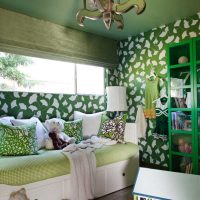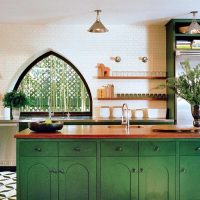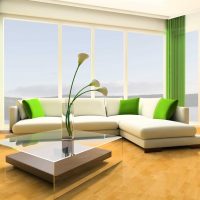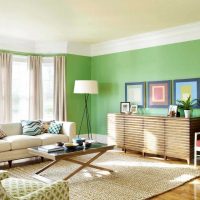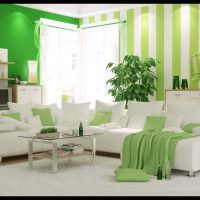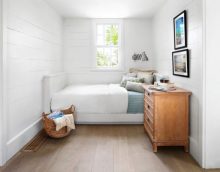The combination of green with other colors in interiors of different styles
Green color is the most common in nature, but underestimated in the interior decoration. This is probably due to the complexity of choosing the most pleasant combination of green with other tones. Designers have learned to use most green shades, choosing the perfect combination for them. But it is always used in dosage, adhering to certain recommendations.

It’s hard to match the green color to green.

Green is not very popular in decoration

Using green color in the interior you need to adhere to the recommendations
Content
How green is perceived in the interior
Green is the most paradoxical color. It belongs to the cold gamut of the spectrum, but it is the “warmest” of the cold, with the exception of a shade of Arctic ice. Therefore, several indoor plants can revive and give a special aura of hospitality even in the living room in gray or black and white.
In the interior of the hallway, the combination of light green color with other natural shades is well perceived. In the bedroom, children's and teenage rooms, not only pure natural tones, but also mixed ones are appropriate:
- the color of milk green (like poplar buds);
- yellow-green (young anise, unripe lime);
- blue-green (aquamarine).
This color has the largest number of natural shades, the names of which are among some peoples, but in our language there are no analogues or translation. Most often they are associated with those plants or fruits that are unknown in our latitudes. Most recently, we learned what the shade of "lime" or "blue agave". Some Amazonian tribes do not have a separation between turquoise, light green and blue - this is “deep water”.
In our language environment, the names “onion”, “pea”, “pine” or “gasoline” are not used. They sometimes appear in foreign clothing catalogs after a literal translation. The color of pine needles is a favorite among Norwegians and Swedes. Dark green (needles) with white and blue is a natural combination, it is the “Northern Three”. This trio often appears in the interiors and upholstery of IKEA upholstered furniture in the spirit of Scandinavian minimalism, as in the photo.

In the bedroom, the green color will look great

The combination of green and chocolate in the interior of the living room will create a special atmosphere.
Human vision is able to distinguish hundreds of shades, identifying in consciousness in images. Not all are used in the interior of an apartment. The color of cloth in a billiard room with mahogany is an exquisite English classic.
The expression “longing green” refers to the gray-green color. It is undesirable to use it in the personal space of depression-prone people and in the crying of crying children. It will not bring benefits in the office of creative people. But the emerald and the color of the sea wave can awaken deep creative strata, if combined with silver-green.
“Poisonous” green fences and porches, painted corridor panels in schools and kindergartens of the Soviet period are the most unpleasant color. For many, he discouraged the use of more aesthetic shades of green in his homes and apartments.
Nobody will refuse cozy modern kitchen furniture with a facade of a shade of “green apple” or “cold mint”. They cause pleasant sensations and “mouth-watering” associations, are successfully used even in fashionable clothes, but are not suitable for every color type of face. But these tones are easy to combine with shades of green and with other colors in the interior of a modern kitchen.
Most green shades are bright, rich and cheerful in perception. They do not tire, do not overload, on the contrary, they reduce the voltage from visual analyzers. Therefore, psychologists recommend that people with a tremendous load on vision and intelligence in the recreation area use photo wallpaper. It is better to choose paintings with natural landscapes that evoke a pleasant sensation, or with well-groomed corners of landscape design. This is one of the reasons why this color should be present in the interior of the urban "stone jungle."

Green color in the interior should be used in moderation

Green curtains in the kitchen perfectly complement the interior

Most green shades are vibrant, vibrant and perceptive.
Another reason - a person for a normal existence and psychological relief is not enough proximity to nature. Citizens experience this need at a subconscious level. Therefore, all (to a greater or lesser extent) need indoor colors and pets, in a combination of natural shades with green in the interior. Home "living creatures", succulents or orchids help relieve stress and bring yourself back to normal.
A variety of green shades in the urban interior
Natural shades evoke pleasant memories, nostalgia for the happy times of rural childhood, they call for long journeys. For different nations, this color symbolizes hope and tenderness, health and longevity. Therefore, in most ethnic groups, the combination of green and terracotta, heavenly blue and the sun's rays are present in the decor of the home. It is advisable to take these tones for the interior in an urban environment.
Feng Shui adherents also recommend using different shades of green. In the decor of many interiors, there are often dollar bills (or their color) or succulent “money tree” - a decor with financial overtones, also “greens”.
Professional decorators, colorists, florists and designers know the properties of the shades of this color. He skillfully apply a combination of different colors with green, transforming old apartments beyond recognition, where every day you get a positive charge.

Green color goes well with other shades

In modern design, the green color will look advantageous
The most suitable shades for interior design:
- olive;
- emerald;
- jade;
- light green;
- mint;
- lime
- dark green;
- herbal;
- green apple;
- turquoise;
- khaki (protective or military);
- yellow green (anise);
- Arctic ice color.
The "Color of Life" is obtained by mixing two spectral tones - blue and yellow (sky and sun), which enhances their interaction. Experts consider it a symbol of the distant energy of stars and untold potential.
It is recommended to use “cold” backlighting of diodes as local lighting, for example, in a bedroom, dressing room or hallway. The green “light of hope” returns clarity of thought and energy spent during the day, especially after water procedures in the green interior of the bathroom.

Moderate use of green in the bedroom interior will create a pleasant atmosphere for relaxation

Green pillows in the living room will complement the interior of the room.

The green ceiling in the dining room will look unusual and beautiful.
How to choose shades of green?
A noble combination of light green with white, beige and brown is ideal for a modern interior, but other options cannot be ignored.
Basic rules for using the color palette.
TABLE
|
1. |
Basic tone or background (floor, ceiling and walls) |
It is advisable to take light, blurry and neutral tones - this is the atmosphere |
|
2. |
Companion Colors |
Different, create a general harmony, preferably equally saturated |
|
3. |
Contrast colors |
Dark, add variety, create patterns, visually expand |
|
4. |
Emotional Emphasis |
Bright, make the interior interesting, memorable, attractive |
|
5. |
Colors for balance |
Calm spectral colors dilute plain design |
|
6. |
Closely related shades |
Variations of the predominant color in mixed or pure form |
|
7. |
Personal preferences |
Several items of your favorite color give a personal touch |
Attention! When choosing a color, remember that it is better to choose a dark bottom and a light top - a subconscious sense of stability (like earth and sky). Emotional accents - opposite the eyes in the recreation area. If life is too saturated, then the interior decor should not overload the perception.

This combination of colors in the kitchen will give only a positive mood

Green color is combined with almost all colors
For example, in the green matrimonial bedroom you can take a dark brown parquet, a white ceiling and mint or lime walls. The room is complemented by beige curtains, white furniture and decor in green colors. Favorite pink or lilac color - orchids or flowers in a vase. Emotional emphasis - a picture on an empty wall or behind the head of the bed. The night illumination of the green diode strip along the perimeter of the ceiling will complement the magic of an intimate atmosphere.
Tip. Everyone has their own favorite palette, but it is worth considering:
- “Cold” shades are suitable for rooms on the south side;
- “warmer” in perception - for northern windows;
- “Edible” shades of green are suitable for the food intake area;
- neutral colors - in the recreation area;
- natural tones are appropriate in a children's room, suitable for a work area or office.
Whatever the choice, there is a lot of green in the living space - too much, although it is an “anti-stress” color. The exception is the greenhouse on the insulated loggia and any shades of green in the hallway, where they do not linger for a long time, but are immersed in the atmosphere of the house. The overall balance of interior design involves not only the tones of surface cladding and textiles, but also live greens.

In the dining room, yellow curtains and a green floor will look advantageous

A green sofa against white walls will stand out very well

The green color in the interior should be in moderation
Choose combinable with green.
Each designer has his own list of tones that blend perfectly with green, but can be complemented to your liking. The green color is universal, it is associated with spring and youth, it has several beneficial combinations in the interior.
Ideal companions for many shades of green.
- White (milky) and blue.
- Beige and brown.
- Peach and yellow.
- Blue and turquoise.
- Sandy and almost all woody shades.
The green color is universal, it is associated with spring and youth, it has several beneficial combinations in the interior.
TABLE
|
The foundation |
Friendly colors |
Contrasts and accents |
|
1. Lime |
Citric |
Burgundy, golden |
|
2. Mint |
Blue |
Blue silver |
|
3. Malachite |
Amber |
Mustard black |
|
4. Emerald |
Golden |
Graphite, light blue |
|
5. Jade |
Beige, Cream |
Red chocolate |
|
6. Lime |
Emerald |
Fuchsia, purple |
|
7. Green apple |
Pink |
Black Brown |
Attention! You can choose the right combinations based on personal preferences and your taste. Often recommend an olive tone with lavender, mustard and blue, as is customary in the Provencal style. But this "classic quartet" will not be perceived in any other style.

An ideal option for the interior is a light top and a dark bottom

You can choose the color from your preferences
There are favorites for different stylistic decisions:
- provence is olive;
- English classics - the color of billiard cloth;
- futurism - neon green;
- avant-garde - acid;
- Eastern - emerald;
- safari and colonial - khaki, etc.
Light green (warm green) and mint (cold green), yellow-green, and emerald (saturated dark green) are positively perceived in the interior. In most cases, shades of fresh greens blend well:
- with golden and silver;
- with yellow and white;
- with brown and beige;
- with purple and violet;
- with pink and lilac;
- with red and burgundy;
- with chocolate and black.
If this or that color combination that causes unpleasant associations is prescribed by the rules or specialists, it is better to refuse them in favor of more pleasant and relaxing combinations.
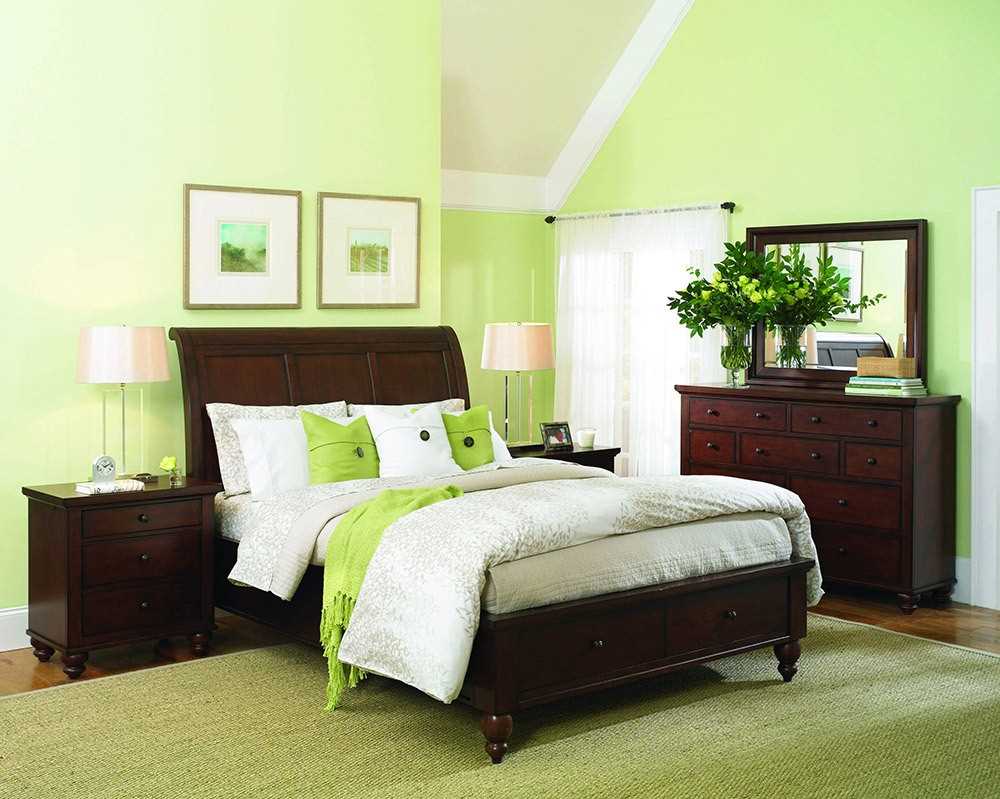
Green color in the bedroom will create a pleasant atmosphere for relaxation.

Lighting in the room plays an important role

If you follow the recommendations of a specialist, you can create a stunning design
In which styles are green shades appropriate?
Juicy optimistic shades of fresh greenery can ennoble and revitalize any urban space. Even if a hi-tech or a loft is chosen, several large plants or a large aquarium with green aquafits will transform them beyond recognition, providing them with “live” power. But each style dictates its own rules. Natural shades of green are most appropriate in minimalism, country and ethno, new combinations offer avant-garde and futurism, kitsch and eclecticism.
- In an urban environment, it is very fashionable to design apartments in eco-style, where they use a natural palette and natural materials. These are wood, bamboo and cork, natural and “wild” stone, floors - with a laminate in the color of a wenge tree (chocolate tones). In the bathroom and hallway - marble tiles or porcelain tiles with imitation of natural textures. All vegetable shades are used.
- Japanese minimalism is the simplest and most organic style with emphasized asceticism and a preference for natural textures. Greens of bamboo and twigs of blossoming sakura are favorites of the decor. Bonsai and paintings with corners of Japanese nature are widely used, but in each room there is only one. A style with a minimal color burden, where instead of bright color accents - images of hieroglyphs, a collection of dishes or cold steel. Simple geometric shapes, simple color combinations, against a white background, with the use of wood and green shades.
- Without natural shades of green, romanticism, retro-style and country are also unthinkable, where they are presented in the form of floral ornaments. Textile in a small flower, embroidery with satin and cross stitch, homespun textile and handmade tablecloths - greens are used everywhere. The ornament on rugs and bedspreads, curtains and removable covers on furniture also does not do without natural colors. The most luxurious shades of green are presented with yellow and pink, red and blue.
- An exciting combination of green with other shades is acceptable in an eclectic style, an avant-garde and futuristic interior. Acidic, saturated and defiant shades should still be used in a metered way, in the form of accents or extravagant decor. In the bedroom, you can focus on spectacular lighting and objects of the original form. The favorites are neon green, which harmonizes with white and lemon, especially if it is textile.
- In modern style, generated by the technogenic era, which suppresses the ecology, natural greens are used in the form of small "oases" on a gray background. They enliven chrome and plastic surfaces, white walls and eco-leather upholstered furniture. Lighting design is a popular technique, but remember that diode lighting distorts the natural shades of light green walls. They will be perceived differently day and evening. It is important to correctly choose the decor and color accents, showing taste and sense of proportion.

Green goes well with pink
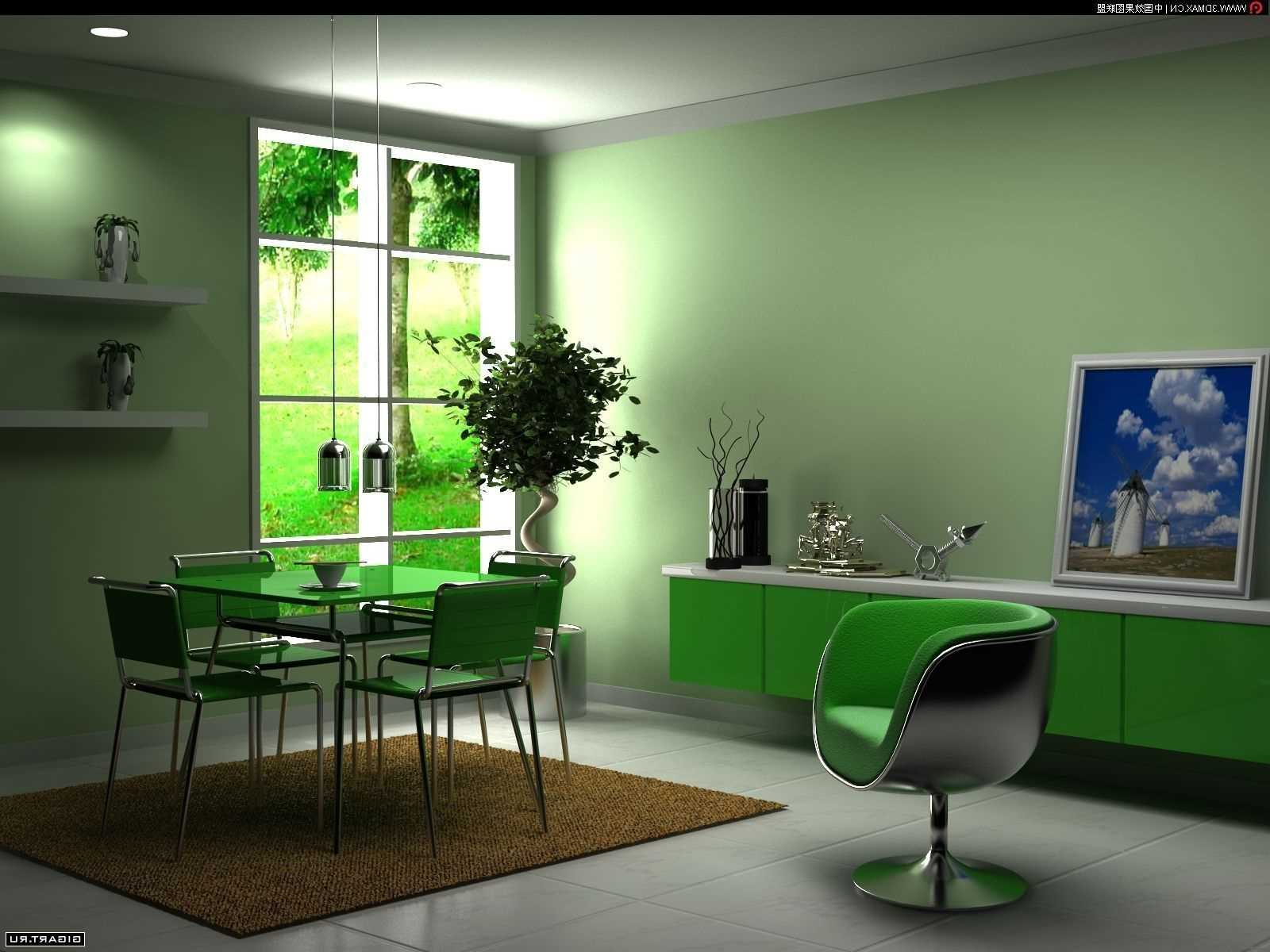
Green color blends very well with many styles.
Bright shades are inappropriate in the historical style and in the classic interior. Showing the whim “I like it” ”, you can spoil the impression of the most exquisite interior in the Baroque style, the Renaissance or Empire, where the“ anti-stress color ”is used dosed. Most often, it is present in the form of a picture on a tapestry or other textile.
When designing an author's interior, it is better to be careful in combination with black and purple, as well as with bright shades - fuchsia, orange, red and raspberry. When decorating common rooms, it is important to consult with other family members so that the selected combination of green with other colors does not annoy anyone. Learn exquisite combinations on the examples of our photo gallery.
Video: Green in the interior


